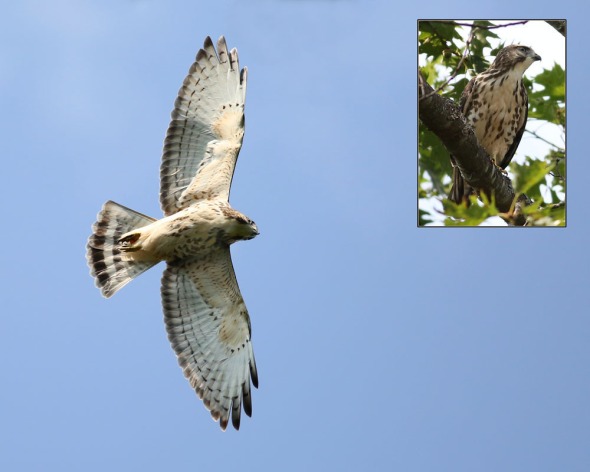Peak of Broad-winged Hawk Migration
 We are currently at the peak of the Broad-winged Hawk fall migration, an annual event that birders look forward to with great anticipation. These birds are gregarious, often migrating in flocks or groups called “kettles” that range from several individuals to many thousands of birds. In New England in mid-September it’s possible to see 10,000 Broad-winged Hawks a day at a hawk watch site; near the Great Lakes, 50,000 a day and Texas hawk-watchers have been known to see 300,000 to 500,000 a day.
We are currently at the peak of the Broad-winged Hawk fall migration, an annual event that birders look forward to with great anticipation. These birds are gregarious, often migrating in flocks or groups called “kettles” that range from several individuals to many thousands of birds. In New England in mid-September it’s possible to see 10,000 Broad-winged Hawks a day at a hawk watch site; near the Great Lakes, 50,000 a day and Texas hawk-watchers have been known to see 300,000 to 500,000 a day.
Broad-wings depend more on thermals, rising columns of warm air, during their migration than most raptors. They don’t usually begin flying until mid-morning, by which time the sun has created thermals, and they stop flying as soon as thermal production ceases in later afternoon. During the day kettles can be seen circling around and around, higher and higher as they ride thermal columns of air upwards, peeling off at the apex and soaring (saving energy other migrating hawks use flapping their wings) southwards towards their wintering grounds.
To find hawk watch sites in your part of the world, go to the Hawk Migration Association (http://www.hmana.org/hawk-watch-sites/).
Naturally Curious is supported by donations. If you choose to contribute, you may go tohttp://www.naturallycuriouswithmaryholland.wordpress.com and click on the yellow “donate” button.


















Mary, have you ever sen our TV special called “Journey of the Broad-Winged Hawk”?
September 15, 2016 at 8:17 am
No, but I’d love to. How would I go about doing so?
September 15, 2016 at 9:05 am
This is very interesting, Mary. Walking in Harvard’s Arboretum in Boston one morning just over a week ago, I had never seen so many hawks gathering and circling. It hadn’t occurred to me that they might be migrating. http://www.audubon.org/field-guide/bird/broad-winged-hawk The call recorded on this page sounded like them but I did not identify them at the time.
We noticed one hawk, clinging to a large nest near the top of a tree, then realized that it was trying to dig through the leaf bundle of a squirrel’s drey. The squirrel was evidently still inside and the hawk was making short work of the leaf layers, when a pair of blue jays arrived to see the intruder off. While the hawk was distracted, the squirrel made a brave escape down the tree trunk and looked ready to die of fright. The mobbed hawk eventually gave up and Boston kept another squirrel.
We had been to the Robert Frost Interpretive Trail in Ripton, VT the week before and I was feeling a bit sorry for myself that I had to be a city walker and see so little wildlife. Immediate attitude correction. Much to see right where I was!
September 15, 2016 at 9:26 am
Fascinating to read your description – can’t imagine being lucky enough to see it firsthand! Thank you for sharing.
September 15, 2016 at 7:11 pm
Hi Mary,
Check out what Eric Masterston is doing–www.harriscenter.org So far heâs biked to Hawk Mountain.
Meade
September 15, 2016 at 10:08 am
Mary, you may have heard of the journey being undertaken by Eric Masterson, who left NH within the last week to follow the migration of the broad-winged hawk on his bike. Quite exciting! His story is here: http://ericmasterson.com/
September 15, 2016 at 6:09 pm
We finally had a confirmed Monarch sighting yesterday, September 15, in our meadow in Bethlehem, NH. It may have been just a single butterfly, because we never saw more than one at a time, but it seemed like a miracle!
September 16, 2016 at 10:00 am